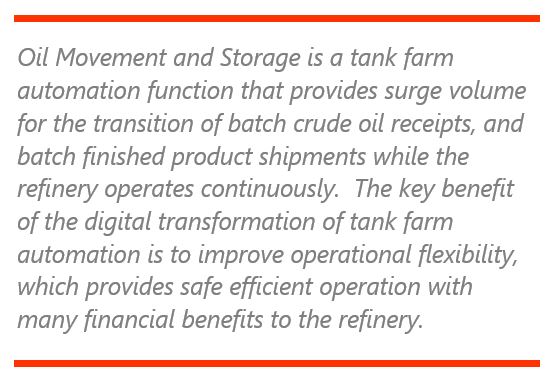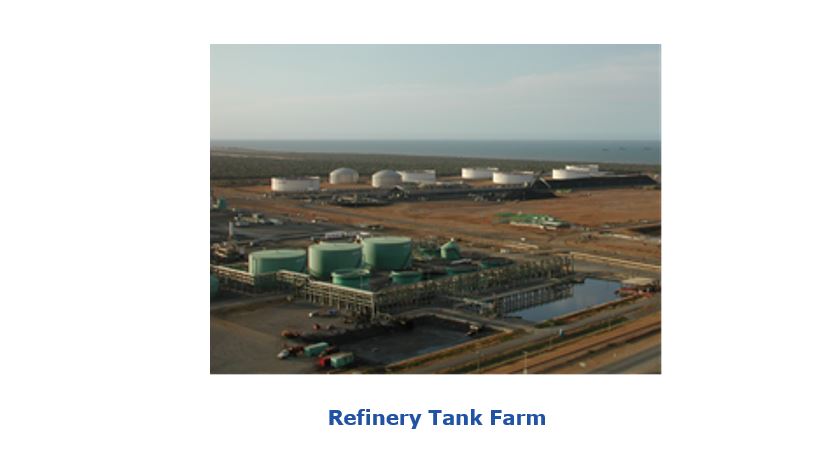

Digital Transformation of Tank Farm automation for Oil Movement and Storage builds on the legacy of established best practices. It is essential that digital automation applied to oil movements and storage be compatible with the important refinery and terminal infrastructures and be compatible with various software packages and stakeholders throughout the operation.

A key benefit of tank farm automation in refineries is to improve "operational flexibility", which provides safe operation within many operational constraints. The ability to accommodate a low-cost crude purchase or deliver a finished product within a specific time, provides financial benefits to both refinery operation and to supply chain management. As these enterprise systems become more digitized, it is essential that the tank farm automation integrates well with them.
"Operational Flexibility" allows the refinery to run with less changes to unit operations flowrates and product quality. Alternatively, "Operational Flexibility" allows receipts and shipments to continue with minimal disruption when refinery unit operations are upset, such as an unexpected shutdown of a process unit like the FCC or the hydrocracker.
The refinery runs continuously to process crude into rundown or blend component tanks. The rundown tanks provide surge capacity to meet batch blending and batch product shipments. Operational flexibility is improved if the refinery has many tanks with a large volume to maximize surge capacity. Given that refineries and terminals have a specific number and configuration of tanks, the problem to be solved is how to use those tanks most effectively. Operational flexibility allows oil traders more options to buy the right crude oil at the right prices and to sell specific products to meet constantly changing customer requests.
Of course, tank farms must also be safe and environmentally compliant. It is important to plan feasible movements, line up the piping, and execute the movement without delay or risk of product contamination. With best practices the topology of the piping system is precisely known and built into the tank farm automation system. The status of the piping system, the block valves, the control valves, and all pumps must be known. Planning must take into consideration any leaking valves, defective pumps, as well as other simultaneous material movements that could conflict with the lineup path of other movements. The management for piping paths effectively books or reserves pumps, valves, and piping segments for the duration of a movement. Planning a series of product movements can result in many feasible solutions with many simultaneous movement paths. The selection of particular pumps, flowmeters, valves and pipe segments place limits on the flowrates for feasible paths. This can be a critical decision that impacts the duration of a movement. For example, a blending operation involves lining up multiple rundown tanks to a blend header that flows into a product storage tank. The selection of a small pump or a small flowmeter for the alkylate blending component might limit the blend rate and extend the time required to fill the product tank. This could impact future oil movements by tying up the needed equipment.
Consider a complex material movement operation like blending gasoline. Let's say we need to make a batch of premium gasoline which has specific product specifications for Octane, RVP, Sulfur, and perhaps a dozen other product quality specifications. The blending problem requires the selection of component or rundown tanks and the selection of a product tank. The product tank is typically a floating roof tank that has a significant residual heel volume. Suppose that heel volume was from a previous batch of regular gasoline. Based on the selection of the available components for a planned blend, and the planned blend ratio or formulation, is it even possible to meet the product quality requirements for premium gasoline before the product tank is filled? An additional consideration is whether there is sufficient volume in all the selected component tanks to execute the blend, considering the refinery may be filling the component tanks while the blender is drawing from the same component tanks.

These examples are only part of the many complex situations that arise for Oil Movement and Storage. Suppliers have many solutions for these problems as we discuss below.
Clearly knowing the inventory in a refinery tank farm in real time is a fundamental requirement for automation. There are various technologies for level measurement, and many will include "strapping tables" that convert tank level to stored volume using a look up table. Tanks are not exactly right circular cylinders and they expand and distort when filled.
Tank Gauging Options:
For owner-operators, ARC can provide technology and supplier selection guidance for tank gauging systems.
Tank Information Systems (TIS) are essentially real-time database applications that combine tank level/volume information with product quality information that might be computed, measured with analyzers, or determined by periodic sampling with lab analysis. The TIS could be a stand-alone Industrial Internet of Things (IIoT) edge device with its own graphical user interface, that collects tank gauging sensor information and tank quality information to populate a local database with calculations and alarms. To connect the TIS to blending, movement monitoring or path management, the TIS application needs to integrate to a DCS, PLC, or maybe multiple other edge devices that can perform those functions. It could also be true the TIS edge device connects directly to other databases or enterprise applications in a server or on a cloud. It is not uncommon for all these tank farm applications to be built within the DCS, which can connect them and serve as the primary HMI for these applications. The DCS can of course connect to planning and scheduling applications in the refinery as well as connect to enterprise systems in the cloud.
Movement monitoring and material balance yield tracking applications can display all the active movements with alarms for issues and can keep records for all movement histories. There may be checks, such that the reduction of volume in the source tanks matches flow metering, which matches the gain in volume at the destination tank. Technically, material balance checking is done on a mass basis as mass is conserved. Metering of flowrates can be adjusted using accepted practices to compensate to standard conditions. Movements can be tracked against customer orders.
Path management is essentially a procedural automation function that makes movement line ups happen, starts the flow of the movement, and stops the movement when it is complete or if it needs to be interrupted. The application may involve booking specific equipment and typically requires a complete understanding of the entire tank farm piping network. Where pumps, valves, hoses are not instrumented or automated, path management may require confirmation that manual procedures were accomplished. For example, some hose connections may be required to start an oil movement, but the operator must first confirm the proper hose connections were made.
Refinery tank farms routinely have gasoline and distillate blending systems. As a minimum, a refinery will execute a simple ratio control scheme where selected components are combined into a blend header before they are delivered to a product storage tank or possibly sent to a pipeline. During this blend movement the blend components are maintained in a volumetric ratio, based on flow measurements. In a typical arrangement the flows ramp up to a blend rate, continues at the blend rate until the blend approaches the end, then flows ramp down to a trickle before stopping the blend. Various schemes can handle a situation where one or more components cannot keep up with the required flow which would mean the desired blend ratio would not be achieved. One solution to this is to implement "pacing" to slow the blend rate down in order maintain the blend ratio.
Simple blend ratio control does not respond to upsets in product quality or to errors in estimating the component tank qualities that were used to compute the blending ratios. There are various implementations that use on line analyzers at the blend header for feedback control to adjust the blend ratio during the blending process to insure the blended product meets all product qualities. Some configurations compute the values of some or all blend properties in the product tanks as it is filling, based on analyzers connected to the blend header. Optimization can be arranged for producing the blend at the lowest cost of components, or the objective function can be arranged for an alternate goal, like minimum deviation from starting ratio. In either case the analyzer-based control system attempts to fill a product tank that will meet product specs. An off-spec product tank is problematic as it may require splitting the tank into two volumes with a patch for each. At best, it ties up tankage and delays shippable product. The blend optimization problem typically extends into the refinery operation to keep a proper inventory of blend components and to insure the refinery itself is operated at optimal targets within all operational constraints. Producing the most profitable blended products at the time they are needed has significant impact on refinery profitability.
Where blending can involve a host of analyzers, these analyzers must be managed to insure they deliver reliable and accurate results. Analyzers must be periodically calibrated, and the collection of streaming real-time data must include careful data validations.
Best practices mean safe, environmentally compliant, and efficient operations. This implies maximum operational flexibility, optimal use of surge capacity, movement planning capability, automation of movement lineups, automation of movement procedures, accurate inventory accounting, and smooth integration with business applications, like refinery planning, yield accounting. and environmental health & safety reporting. Digital transformation of Tank Farm technologies and systems can greatly improve all of these.
Tank farm operators execute the movements that involve refinery tanks, pipelines, barges, trucks, rail cars etc. Every facility will have specific physical equipment, instrumentation, control systems, planning and tank farm software and operating procedures. Training of all stakeholders to work cooperatively with clear understanding of roles and responsibilities is an essential best practice. The exact instrumentation, automation, operating procedures, plant operating software, and business applications will vary.
To achieve a top quartile rating, oil movement system requires many different capabilities to work together smoothly. Compared to typical refinery units, tank farm automation touches more business organizations and requires frequent coordination between the operations group, the supply chain and trading group, and the logistics of refinery scheduling and planning groups.
With a broad spectrum of IIoT devices to choose from, ARC suggests field instrumentation from multiple vendors, like tank gauging, can work together seamlessly if they meet the reliability and accuracy requirements and are easy to connect using industry standard communication methods. Where product quality of crude oil impacts refinery operation and finished product quality must meet shipment specifications, the analytical capability, both with on-line analyzers and laboratory analyzers, is also an essential foundation for success.
It is important to clearly identify roles and responsibilities that are consistent with the software integration of business applications and operational applications. As an example, it may be the planning group queues up a sequence of gasoline blends for the next 30 days. Operations may execute a planned blend, but maybe they are forced to make deviations from the recipe due to unforeseen refinery upsets. This in turn may require the blend planner to edit future blends in the queue. It is important for all personnel to be working from accurate and timely data with a single version of the truth.

